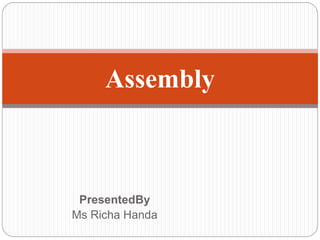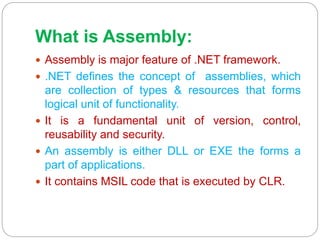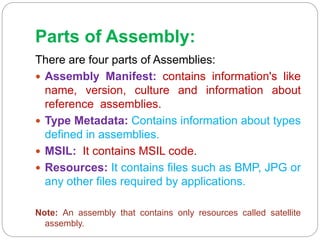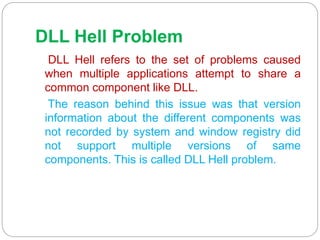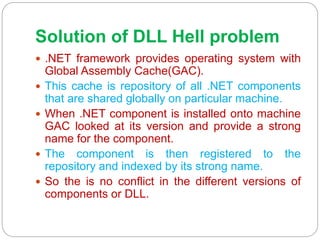Assembly
- 2. What is Assembly: ï Assembly is major feature of .NET framework. ï .NET defines the concept of assemblies, which are collection of types & resources that forms logical unit of functionality. ï It is a fundamental unit of version, control, reusability and security. ï An assembly is either DLL or EXE the forms a part of applications. ï It contains MSIL code that is executed by CLR.
- 3. Some important points related to Assembly: ï Every assembly contains version. ï It contains interfaces and classes. They may also contains Bitmap files etc. ï Every assembly contains assembly metadata, which contains information about assembly. ï CLR uses this information at the time of executing assemblies. ï Assembly may be private which are used only by applications to which they belongs or global assemblies which are used by any application in the system.
- 4. Parts of Assembly: There are four parts of Assemblies: ï Assembly Manifest: contains information's like name, version, culture and information about reference assemblies. ï Type Metadata: Contains information about types defined in assemblies. ï MSIL: It contains MSIL code. ï Resources: It contains files such as BMP, JPG or any other files required by applications. Note: An assembly that contains only resources called satellite assembly.
- 5. DLL Hell Problem DLL Hell refers to the set of problems caused when multiple applications attempt to share a common component like DLL. The reason behind this issue was that version information about the different components was not recorded by system and window registry did not support multiple versions of same components. This is called DLL Hell problem.
- 6. Solution of DLL Hell problem ï .NET framework provides operating system with Global Assembly Cache(GAC). ï This cache is repository of all .NET components that are shared globally on particular machine. ï When .NET component is installed onto machine GAC looked at its version and provide a strong name for the component. ï The component is then registered to the repository and indexed by its strong name. ï So the is no conflict in the different versions of components or DLL.
- 7. Thank you!
